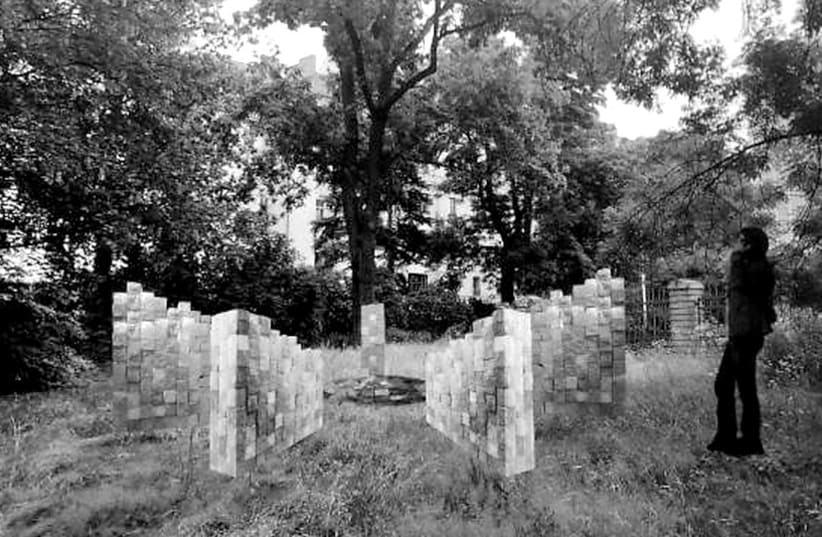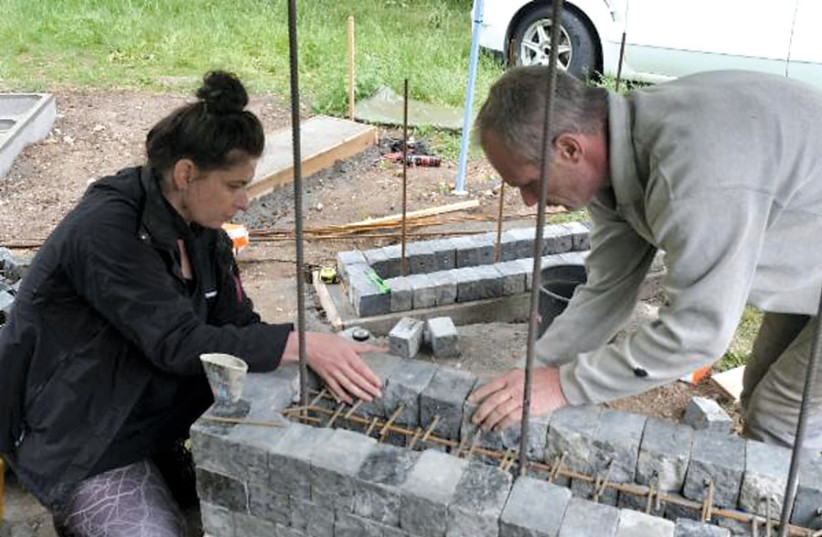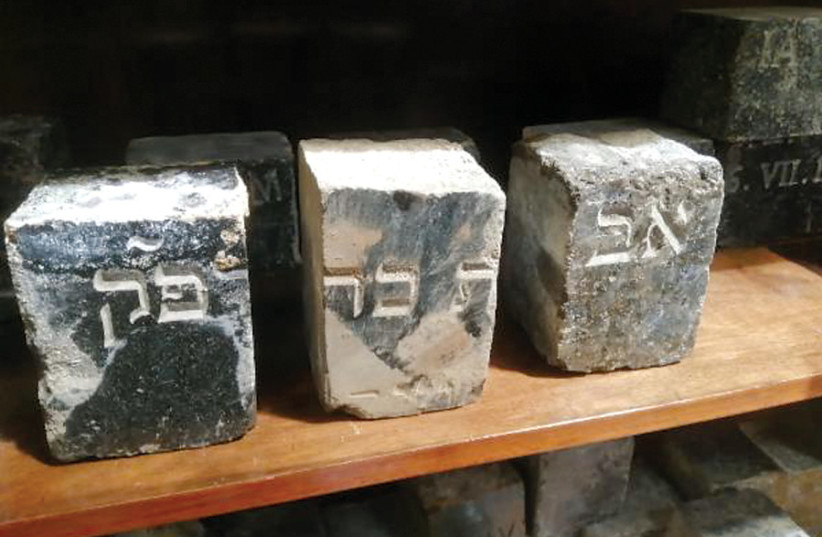In Prague, as across the Iron Curtain, historic if derelict prewar Jewish cemeteries were looted by the Communist government, their granite and marble matzevot (tombstones) repurposed as construction material.
On September 7, husband and wife artists Lucie and Jaroslav Rón are unveiling The Return of the Stones monument at the New Jewish Cemetery (Nový židovský hřbitov) in funky Žižkov – three kilometers away from the famous Old Jewish Cemetery in the former medieval ghetto area called Josefov.
The couple sculpted their symbolic monument using seven tons of cobblestones, each bearing an incomplete inscription chiseled in Hebrew, Czech or German, or a few numbers from a partial date. The pillaged masonry, which had been cut into 10sq.cm. paving blocks, was returned to the Jewish community following a 2019 memorandum signed by the Prague municipality and the Technical Administration of Roads.
The 750,000 Czech crowns ($31,000) memorial, paid for by a crowd-funding campaign, resembles the sun’s rays emanating from a circle, with the cobblestones stacked in walls of unequal height. The stones were salvaged from the heavily trafficked pedestrian promenade along Na Příkopě Street at the south end of Prague’s tony Wenceslas Square. They had originally been laid there in a mosaic pattern in 1987 ahead of Soviet leader Mikhail Gorbachev’s hour-long walkabout in the storied Old Town. Their polished side and inscription were placed facedown, leaving the rough granite on the surface. At the time, workers noted the cobblestones’ origin.
In 2014, Leo Pavlat, director of Prague’s Jewish Museum, wrote an article about them for Czech Radio. Pavlat recalled how on his way to work at the Albatros publishing house in the 1980s, during the refurbishment of the Na Příkopě promenade, he noticed piles of cube-like cobblestones heaped up and ready to be laid, and recognized they had been cut from Jewish tombstones. He pocketed two stones, which he preserves to this day – one bearing a Hebrew letter, the other the date 1895.
In the reverse of German artist Gunter Demnig’s Stolpersteine (stumbling blocks) project in which more than 100,000 brass plaques have been embedded in sidewalks across Europe documenting where a victim of Nazism last lived, here the almost anonymous stones recall the Jews of Bohemia and Moravia who died peacefully before the Holocaust.
Notwithstanding the difficulty of identifying the tombstones from their fragmentary inscription, Radio Prague International reported in 2019 about a cemetery and gravestone documentation project called Finding the Lost Faces of Jewish Cemeteries. Financed by the Czech Culture Ministry and the Czech-German Fund for the Future, the project is being carried out by the Prague monuments preservation company Omnium Z.S.
Some of the cobblestones were likely stolen from the New Jewish Cemetery, though more than 300 prewar Jewish cemeteries across Bohemia and Moravia were mined for their cut stone.
Žižkov: From wine-growing district to cemetery
Once a rural wine-growing district, Žižkov became a plague cemetery in the 17th century. The Jewish burial ground was consecrated in 1890 when the historic Old Jewish cemetery in today’s Fibichova Street ran out of space.
Upgraded from a town to a city by Emperor Franz Josef in 1881, Žižkov was incorporated into Prague in 1922, four years after Czechoslovakia gained independence at the end of World War I. The cemetery was designed to hold 100,000 graves, which would have sufficed for a century had 77,297 Jews from the so-called Nazi Protectorate of Bohemia and Moravia not been deported to their deaths elsewhere, and 153 communities annihilated. The Nový židovský hřbitov is more than 10 times larger than the Old Jewish cemetery in Josefov.
There are upwards of 12,000 headstones in the old cemetery, though it is speculated that as many as 100,000 individuals are buried beneath them, stacked 12 deep in some places. Halacha forbids the removal of old graves, so the dead were simply piled on top of one another for centuries. New dirt was trucked in to allow space for further burials.
One by one, the New Jewish Cemetery’s tombstones disappeared during the Communist era. In the 1980s, much of the burial ground was seized to enlarge the Mahler Gardens (Mahlerovy sady) and build the adjacent landmark 216-meter tall Žižkovka Television Tower, Prague’s tallest structure.
The grave most frequently visited by foreigners is that of the German-speaking Bohemian novelist Franz Kafka (1883–1924) and his parents, Hermann and Julie. Designed by architect Leopold Ehrmann (1886-1951), it is shaped as a hexahedral truncated crystal cube with information in Hebrew on the family on the front face.
Kafka ranks as Prague’s second-most famous Jewish son after Rabbi Judah Loew ben Bezalel (1520-1609), who according to legend fashioned a Golem to protect the ghetto from antisemitic plots. The hulking clay homunculus, created with Kabbalistic sorcery, faithfully served the sage until one day it ran amok. Rabbi Loew erased the letter aleph from the Hebrew word emet (truth), which he had inscribed on the Golem’s forehead. The remaining two letters spelled met (dead) – and the Jewish Frankenstein fell silent.
During his abbreviated life – Kafka died of tuberculosis at 41 – he penned such classics as The Trial, The Castle and Amerika. A statue marks the writer’s birthplace in the former Three Wells Square, once the ghetto’s boundary. Banned by the Communists, Kafka today has been rehabilitated as a Czech national hero. A museum opened in his former home in 1991.
Opposite Kafka’s tomb is a bronze plaque commemorating Max Brod (1884-1968), who saved his friend’s literary legacy.
Among the remaining tombstones are several in the Art Nouveau or Jugendstil style popular in fin-de-siècle Prague and elsewhere in the Austro-Hungarian Empire, including the black granite tomb of Nathan Ehrenfeld (1843-1912), who was installed as chief rabbi of Prague in 1890. Perhaps anticipating the Holocaust, the Csusz, Hungary-born Orthodox scholar unequivocally opposed cremation and prohibited the burial of urns in Prague’s New Jewish Cemetery.
Also extent is the cemetery’s still-in-use hevra kadisha (funeral brethren) hall and chapel, the administration and auxiliary buildings where carpenters fashioned coffins, and the gate and wall around the graveyard, all built in the contemporary ruling style: neo-Renaissance.
“More important for us are the things that we can still fix.”
František Bányai
František Bányai, head of Prague’s 2,000-member Jewish community, praised the new memorial, but said that issues of greater necessity deserve attention.
“More important for us are the things that we can still fix,” said Bányai. “That means maintaining current cemeteries, or those that can still be repaired. There is still a deficit ranging in the tens of millions of crowns in this regard. We also want to focus on those synagogues that can still be repaired, as well as social care for elderly survivors.” ■
Contacts:
New Jewish Cemetery (Nový židovský hřbitov)Izraelská 1130 00 Praha 3 – Žižkov+420 226 235 216+420 224 800 813http://www.synagogue.czhttp://www.kehilaprag.czrabinat@kehilaprag.cz


